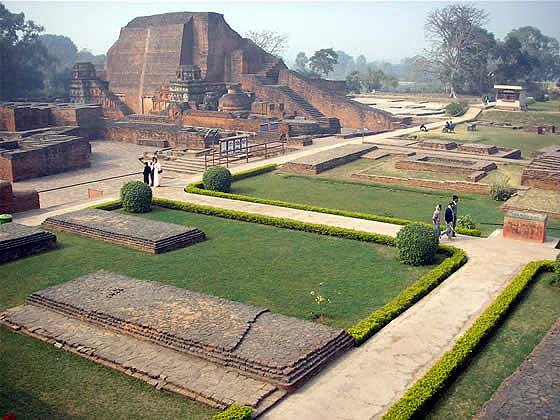|
Indian Logic
The development of Indian logic dates back to the Chandahsutra of Pingala and '' anviksiki'' of Medhatithi Gautama (c. 6th century BCE); the Sanskrit grammar rules of Pāṇini (c. 5th century BCE); the Vaisheshika school's analysis of atomism (c. 6th century BCE to 2nd century BCE); the analysis of inference by Gotama (c. 6th century BC to 2nd century CE), founder of the Nyaya school of Hindu philosophy; and the tetralemma of Nagarjuna (c. 2nd century CE). Indian logic stands as one of the three original traditions of logic, alongside the Greek and the Chinese logic. The Indian tradition continued to develop through early to modern times, in the form of the Navya-Nyāya school of logic. Origins The Nasadiya Sukta of the ''Rigveda'' ( RV 10.129) contains ontological speculation in terms of various logical divisions that were later recast formally as the four circles of '' catuskoti'': "A", "not A", "A and 'not A'", and "not A and not not A". Medhatithi Gautama (c. 6th cen ... [...More Info...] [...Related Items...] OR: [Wikipedia] [Google] [Baidu] |
Anviksiki
Ānvīkṣikī is a term in Sanskrit denoting roughly the "science of inquiry" and it should have been recognized in India as a distinct branch of learning as early as 650 BCE. However, over the centuries its meaning and importance have undergone considerable variations. In the earliest period, the term was used to denote Atma-vidya, the science of the soul, in contrast to Adhyatma-vidya, the spiritual science, or Brahma-vidya, the divine science. In Manu Smriti the term Ānvīkṣikī has been used as equivalent to Atma-vidya and it has been described as a branch of the Vedas. In the fourth century BCE, Kautilya in his Arthashastra recognised it as a distinct branch of learning different from Vedas and other disciplines. Kautilya classifies all disciplines into four categories: scripture (the three Vedas, ''trayi''), agriculture and commerce (''varta''), politics and public administration (''danda-niti''), and ''Ānvīkṣikī'', the investigative reflective science. The distincti ... [...More Info...] [...Related Items...] OR: [Wikipedia] [Google] [Baidu] |
Origin Of The Universe
Cosmogony is any model concerning the origin of the cosmos or the universe. Overview Scientific theories In astronomy, cosmogony is the study of the origin of particular astrophysical objects or systems, and is most commonly used in reference to the origin of the universe, the Solar System, or the Earth–Moon system. The prevalent cosmological model of the early development of the universe is the Big Bang theory. Sean M. Carroll, who specializes in theoretical cosmology and field theory, explains two competing explanations for the origins of the singularity, which is the center of a space in which a characteristic is limitless (one example is the singularity of a black hole, where gravity is the characteristic that becomes infinite). It is generally accepted that the universe began at a point of singularity. When the universe started to expand, the Big Bang occurred, which evidently began the universe. The other explanation, held by proponents such as Stephen H ... [...More Info...] [...Related Items...] OR: [Wikipedia] [Google] [Baidu] |
Classical Logic
Classical logic (or standard logic) or Frege–Russell logic is the intensively studied and most widely used class of deductive logic. Classical logic has had much influence on analytic philosophy. Characteristics Each logical system in this class shares characteristic properties: Gabbay, Dov, (1994). 'Classical vs non-classical logic'. In D.M. Gabbay, C.J. Hogger, and J.A. Robinson, (Eds), ''Handbook of Logic in Artificial Intelligence and Logic Programming'', volume 2, chapter 2.6. Oxford University Press. # Law of excluded middle and double negation elimination # Law of noncontradiction, and the principle of explosion # Monotonicity of entailment and idempotency of entailment # Commutativity of conjunction # De Morgan duality: every logical operator is dual to another While not entailed by the preceding conditions, contemporary discussions of classical logic normally only include propositional and first-order logics. Shapiro, Stewart (2000). Classical Logic. In St ... [...More Info...] [...Related Items...] OR: [Wikipedia] [Google] [Baidu] |
Buddhist Philosophy
Buddhist philosophy is the ancient Indian Indian philosophy, philosophical system that developed within the religio-philosophical tradition of Buddhism. It comprises all the Philosophy, philosophical investigations and Buddhist logico-epistemology, systems of rational inquiry that developed among various schools of Buddhism in ancient India following the ''Parinirvana, parinirvāṇa'' of Gautama Buddha (c. 5th century BCE), as well as the further developments which followed the Silk Road transmission of Buddhism, spread of Buddhism throughout Asia. Buddhism combines both philosophical reasoning and the Buddhist meditation, practice of meditation.Siderits, Mark. Buddhism as philosophy, 2007, p. 6 The Buddhist religion presents a multitude of Buddhist paths to liberation; with the expansion of early Buddhism from ancient India to Sri Lanka and subsequently to East Asia and Southeast Asia, Buddhist thinkers have covered topics as varied as cosmology, ethics, epistemology, logic ... [...More Info...] [...Related Items...] OR: [Wikipedia] [Google] [Baidu] |
Kanada (philosopher)
Kanada may refer to: *Kaṇāda, the Hindu sage who founded the philosophy of Vaisheshika *Kanada (family of ragas), a group of ragas in Hindustani music *Kanada (surname) *Kanada Station, train station in Fukuoka, Japan *Canada, a country in North America (as it is spelled in many languages) *Kanada warehouses, Auschwitz, storage facilities in Auschwitz for looted property *Kanada (treehopper), ''Kanada'', a genus of treehopper See also *Canada (other) *Kannada (other) *Kaneda, a Japanese surname *Kanata (other) *Kanhar (other) {{disambiguation ... [...More Info...] [...Related Items...] OR: [Wikipedia] [Google] [Baidu] |
Arthashastra
''Kautilya's Arthashastra'' (, ; ) is an Ancient Indian Sanskrit treatise on statecraft, politics, economic policy and military strategy. The text is likely the work of several authors over centuries, starting as a compilation of ''Arthashastras'', texts which according to Olivelle date from the 2nd c. BCE to the 1st c. CE. These treatises were compiled and amended in a new treatise, according to McClish and Olivelle in the 1st century CE by either an anonymous author or Kautilya, though earlier and later dates have also been proposed. While often regarded as created by a single author, McClish and Olivelle argue that this compilation, possibly titled ''Daņdanīti'', served as the basis for a major expansion and redaction in the 2nd or 3rd century CE by either Kautilya or an anonymous author, when several books, dialogical comments, and the disharmonious chapter-division were added, and a stronger Brahmanical ideology was brought in. The text thus became a proper ''arthashast ... [...More Info...] [...Related Items...] OR: [Wikipedia] [Google] [Baidu] |
Chanakya
Chanakya (ISO 15919, ISO: ', चाणक्य, ), according to legendary narratives preserved in various traditions dating from the 4th to 11th century CE, was a Brahmin who assisted the first Mauryan emperor Chandragupta Maurya, Chandragupta in his rise to power and the establishment of the Maurya Empire. According to these narratives, Chanakya served as the chief adviser and prime minister to both emperors Chandragupta Maurya and his son Bindusara. Conventionally, Chanakya was identified with Kauṭilya and synonymously Vishnugupta, the author of the ancient Indian politico-economic treatise ''Arthashastra''. ''Arthashastra'' is now thought with high probability to have been composed by multiple authors during the early centuries of the common era—several centuries after the Mauryan period—the backdated identification with Chanakya to have served to add prestige to the work. Chanakya-Chandragupta ''katha'' (legend) There is no documented historical informati ... [...More Info...] [...Related Items...] OR: [Wikipedia] [Google] [Baidu] |
Boolean Logic
In mathematics and mathematical logic, Boolean algebra is a branch of algebra. It differs from elementary algebra in two ways. First, the values of the variable (mathematics), variables are the truth values ''true'' and ''false'', usually denoted by 1 and 0, whereas in elementary algebra the values of the variables are numbers. Second, Boolean algebra uses logical operators such as Logical conjunction, conjunction (''and'') denoted as , disjunction (''or'') denoted as , and negation (''not'') denoted as . Elementary algebra, on the other hand, uses arithmetic operators such as addition, multiplication, subtraction, and division. Boolean algebra is therefore a formal way of describing logical operations in the same way that elementary algebra describes numerical operations. Boolean algebra was introduced by George Boole in his first book ''The Mathematical Analysis of Logic'' (1847), and set forth more fully in his ''An Investigation of the Laws of Thought'' (1854). According to ... [...More Info...] [...Related Items...] OR: [Wikipedia] [Google] [Baidu] |
Mahabharata
The ''Mahābhārata'' ( ; , , ) is one of the two major Sanskrit Indian epic poetry, epics of ancient India revered as Smriti texts in Hinduism, the other being the ''Ramayana, Rāmāyaṇa''. It narrates the events and aftermath of the Kurukshetra War, a war of succession between two groups of princely cousins, the Kauravas and the Pandava, Pāṇḍavas. It also contains Hindu philosophy, philosophical and devotional material, such as a discussion of the four "goals of life" or ''puruṣārtha'' (12.161). Among the principal works and stories in the ''Mahābhārata'' are the ''Bhagavad Gita'', the story of Damayanti, the story of Shakuntala, the story of Pururava and Urvashi, the story of Savitri and Satyavan, the story of Kacha (sage), Kacha and Devayani, the story of Rishyasringa and an Ramopakhyana, abbreviated version of the ''Rāmāyaṇa'', often considered as works in their own right. Traditionally, the authorship of the ''Mahābhārata'' is attributed to Vyasa, Vy ... [...More Info...] [...Related Items...] OR: [Wikipedia] [Google] [Baidu] |
Tetralemma
The tetralemma is a figure that features prominently in the logic of India. Definition It states that with reference to any a logical proposition (or axiom) X, there are four possibilities: : X (affirmation) : \neg X (negation) : X \land\neg X (both) : \neg (X \lor \neg X) (neither) Catuskoti The history of fourfold negation, the Catuskoti (Sanskrit), is evident in the logico-epistemological tradition of India, given the categorical nomenclature Indian logic in Western discourse. Subsumed within the auspice of Indian logic, 'Buddhist logic' has been particularly focused in its employment of the fourfold negation, as evidenced by the traditions of Nagarjuna and the Madhyamaka, particularly the school of Madhyamaka given the retroactive nomenclature of Prasangika by the Tibetan Buddhist logico-epistemological tradition. Though tetralemma was also used as a form inquiry rather than logic in the Nasadiya Sukta of Rigveda (creation hymn) though seems to be rarely used as a tool o ... [...More Info...] [...Related Items...] OR: [Wikipedia] [Google] [Baidu] |
Ontological
Ontology is the philosophical study of being. It is traditionally understood as the subdiscipline of metaphysics focused on the most general features of reality. As one of the most fundamental concepts, being encompasses all of reality and every entity within it. To articulate the basic structure of being, ontology examines the commonalities among all things and investigates their classification into basic types, such as the categories of particulars and universals. Particulars are unique, non-repeatable entities, such as the person Socrates, whereas universals are general, repeatable entities, like the color ''green''. Another distinction exists between concrete objects existing in space and time, such as a tree, and abstract objects existing outside space and time, like the number 7. Systems of categories aim to provide a comprehensive inventory of reality by employing categories such as substance, property, relation, state of affairs, and event. Ontologists disagree re ... [...More Info...] [...Related Items...] OR: [Wikipedia] [Google] [Baidu] |




